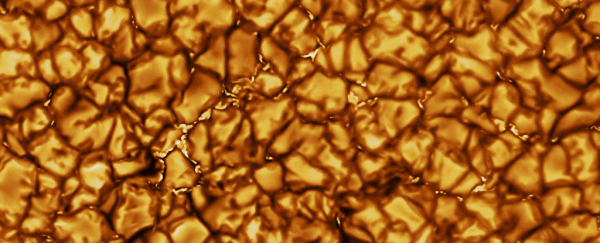A new telescope built to study the Sun has released its first images, and they are just breathtaking. They show the surface of the Sun in the most exquisite detail we've ever seen - revealing convection granules the size of Texas, and tiny magnetic features - the roots of fields that extend far into space.
The telescope that delivered these goods is the National Science Foundation's Daniel K. Inouye Solar Telescope on Haleakalā, Maui. Its incredible observations will provide much greater insight into the wild dynamics of the solar surface, and how they impact us on Earth.
"It is literally the greatest leap in humanity's ability to study the Sun from the ground since Galileo's time," said astronomer Jeff Kuhn of the University of Hawaiʻi at Mānoa's Institute for Astronomy.
"It's a big deal."
Those moving blobs that you see are known as granules. They're the tops of convection cells in the solar plasma, with hot plasma rising in the middle, and then falling back down around the edges as it moves outwards and cools.
Each granule is almost beyond comprehensively large - up to 1,600 kilometres (994 miles) across. The US state of Texas is around 1,270 kilometres (790 miles) long.
 Highest-resolution photo of the Sun's surface ever taken. (NSO/AURA/NSF)
Highest-resolution photo of the Sun's surface ever taken. (NSO/AURA/NSF)
Just taking it all in is pretty amazing, but of particular interest to scientists are those magnetic fields, twisted and tangled by plasma, which can result in powerful solar storms capable of knocking out power grids (albeit extremely rarely) here on Earth.
Less powerful solar storms can still impact communication and navigation systems, and generate gorgeous auroras, but our understanding of and ability to predict space weather is still extremely limited.
This is what scientists are hoping the Inouye Solar Telescope will help to improve.
 (NSO/NSF/AURA)
(NSO/NSF/AURA)
"On Earth, we can predict if it is going to rain pretty much anywhere in the world very accurately, and space weather just isn't there yet," said Matt Mountain of the Association of Universities for Research in Astronomy, which manages the Inouye Solar Telescope.
"Our predictions lag behind terrestrial weather by 50 years, if not more. What we need is to grasp the underlying physics behind space weather, and this starts at the Sun, which is what the Inouye Solar Telescope will study over the next decades."
With its suite of state-of-the-art instruments, some of which are yet to come online, the telescope will be able to measure and characterise these magnetic fields better than we have ever done before.
These measurements could give us a far more advanced warning for solar storms; currently, we generally know about them roughly 48 minutes ahead of time.
Scientists hope that improving our understanding of how magnetic fields behave on the small scale leading up to a solar storm could increase that time to up to 48 hours.
"It's all about the magnetic field," said Thomas Rimmele, director of the Inouye Solar Telescope.
"To unravel the Sun's biggest mysteries, we have to not only be able to clearly see these tiny structures from 93 million miles (150 million kilometres) away, but very precisely measure their magnetic field strength and direction near the surface and trace the field as it extends out into the million-degree corona, the outer atmosphere of the Sun."
Over the coming months, more instruments will beef up the telescope's already hefty power. The Cryogenic Near-Infrared Spectropolarimeter (CryoNIRSP) is designed to take measurements of the Sun's magnetic field out beyond the visible solar disc, in the corona.
The Diffraction-Limited Near-IR Spectropolarimeter (DL-NIRSP) will study magnetic fields and their polarisation with high spectral and spatial resolution.
"These first images are just the beginning," said astronomer David Boboltz of the National Science Foundation's Division of Astronomical Sciences.
"The Inouye Solar Telescope will collect more information about our Sun during the first 5 years of its lifetime than all the solar data gathered since Galileo first pointed a telescope at the sun in 1612."
The telescope is due to be completed by June of this year. We can't wait to see what else it has to show us.
